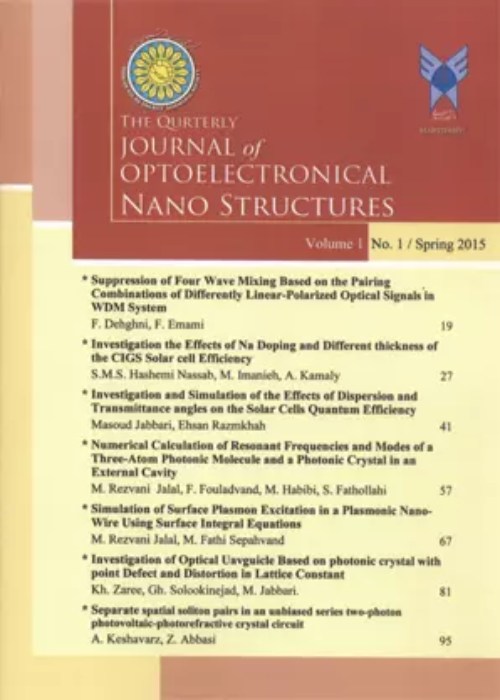فهرست مطالب

Journal of Optoelectronical Nanostructures
Volume:8 Issue: 1, Winter 2023
- تاریخ انتشار: 1402/05/03
- تعداد عناوین: 6
-
-
Pages 1-12This paper presents a novel design of a ternary multiplierbased on graphene nanoribbon field-effect transistor(GNRFET). GNRFET, as a new material with superiorphysical and electronic properties, can be a good choiceinstead of conventional devices such as metal–oxide–semiconductor field-effect transistor (MOSFET) andCNTFET. Moreover, multiple-valued logic (MVL) canhelp to reduce area and decrease the computational stepcompared with binary logic. We proposed a ternarymultiplier with the resistors to produce ternary logic. Theproposed multiplier performances are analyzed byevaluating the delay, power, and power-delay product(PDP), with 15 nm process technologies based onGNRFET. The simulation results with HSPICEdemonstrate that the proposed design frameworkoutperforms state-of-the-art designs in circuit parameters.Keywords: GNRFET, multiplier, MVL circuit, PDP, Ternary logic
-
Pages 13-31For the first time, in this research, we introduce ajunctionless tunneling FET (J-TFET) on a uniform p+starting junctionless FET to realize appreciable immunityagainst inherent high ambipolar current (Iamb). So, weutilize two isolated gates with appropriate workfunctionsover the channel and drain regions to create P+IP+N+charge distribution. This structure utilizes a spacebetween the gate-drain electrodes (SGD), to provide aP+IP+N+ structure thanks to the effective electronsdepletion on the drain side. Increasing the SGD, furthereffectively pulls up the bands near the interface betweenthe channel-drain regions, widens the tunneling width fortunneling to occur, and thus in turn reduces the Iamb from5.37×10-7 A/µm to 1.14×10-14 A/µm. Thus, we point outthat the proposed J-TFET can obtain on-current thatsatisfies the expectation of logic applications with highperformance and Ioff that meets the specifications of lowpower characteristics, a phenomenon that is rarelyaccessible with conventional TFETs.Keywords: Junctionless tunneling field effect transistors (J-TFETs), Band-toband tunneling (BTBT), Ambipolar current, Depletion region, Tunneling barrier width
-
Pages 32-46
In this paper, the effect of using semi-transparent Carbonnanotube layer (CNT) on the efficiency of perovskitesolar cell (PSC) is investigated. One of the mostimportant process in PCS is charge collecting. In thisregard, Carbon nanotubes have the ability to act as chargecollector layer in solar cell. Carbon nanotubes, due tosuitable optical and electrical properties such astransparency, high mobility and stability have beenwidely used in solar cell structures. In the proposedstructure, we use semi-transparent CNT layer as chargecollector on top of PSC. This layer with low resistancepath for transport charge carriers has increased shortcircuit current and other performance parameters of solarcell. The proposed device structureITO/CNT/TiO2/CH3NH3PbI3/Spiro-OMeTAD issimulated with Silvaco TCAD. The simulation resultsshow that the efficiency of the perovskite solar cell withsemi-transparent CNT layer is reached 23.59% which is3.15% higher than simple perovskite solar cell structureunder AM1.5G.
Keywords: Charge Collector, Efficiency, Numerical Simulation -
Pages 47-57A new configuration of an all optical (2 input) NOR gatebased on two-dimensional photonic crystals is proposed.The structure is based on 20*20 rods of silicon in thebackground of air. The square-ring resonator shapedstructure contains three inputs and one output port. Threeinput ports (Ctrl, A and B) are introduced in to thestructure for achieving the appropriate application. Inorder to investigate the functionality of the structure(functioning as a logic NOR gate), photonic band gap(PBG), field distribution and transmitted power spectrumare considered. PBG and field distribution are obtainedconsidering the plane wave expansion and finitedifference-time-domain methods, respectively. All thestates of a NOR gate (truth table or logical values) areconsidered by applying related inputs to the input ports(incident field with the wavelength in the PBG region).The bit rate, normalized intensity and rise time of2.5Tbit/s, 99% and 2ps, are azlso obtained for the gate.The obtained logic NOR gate can be an appropriatecandidate for utilization in optical integrated circuits.Keywords: NOR gate Photonic bandgap Photonic crystal Square, Ring Resonator
-
Pages 58-83
In this study, a new solid phase micro extraction (SPME)fiber coated by sol-gel technology based on polyethyleneglycol (PEG) grafted ionic liquids (ILs), and silicananoparticles (silica NPs) on a porous copper substratewas fabricated. The as-prepared fiber (PEG-ILs-silicaNPs) was then used to extract a variety of pesticides intomato samples before prior to their gas chromatographyflame ionization detection (GC-FID). The key parametersinfluencing extraction efficiency containing includingextraction time, stirring rate, extraction temperature, pH,ionic strength, and desorption temperature, and time wereinvestigated and optimized. The relative standarddeviations (RSDs) for single fiber repeatability rangedfrom 1.2 to 4.6% (n=6), and the RSDs for fiber-to-fiberreproducibility (n=6) were 3.3–6.8%, respectively. Theproposed method based on the PEG-ILs-silica NPs fiberwas successfully applied for the determination of targetedpesticides in tomato samples with good recoveries from89.8 to 103.5% (RSDs=2.1-6.9).
Keywords: Solid-phase microextraction, Solgel, Nanoparticles, Ionic liquids, Pesticide -
Pages 84-94
A multi-wavelength source using a hybrid amplifier comprised of a Semiconductor Optical Amplifier (SOA) and an Erbium-doped fiber amplifier (EDFA) in a ring fiber laser set up is proposed. Multi-wavelength sources are less expensive and more efficient than deploying several laser diodes at different wavelengths. They are also compact, spend low energy, and emit low heat than multiple laser diode systems. A polarization maintaining fiber (PMF) and an interference comb filter are used in conjunction with the suggested few mode fiber laser source to create higer than 14 wavelength around -28 dBm at a SOA by current near 300 mA and a 980 nm pump power of 95 mW. This source is designed by a combined of EDFA and SOA presented in this report. By altering the birefringence of the ring cavity used as a loop mirror and changing the angle of the plates of the polarization controllers, the number of wavelengths produced may be managed. The suggested fiber laser operates at room temperature and has a constant channel spacing of 0.8 nm, making it appropriate for fiber communication and sensing applications.
Keywords: Fiber Laser, ring cavity, PMF, loop mirror

